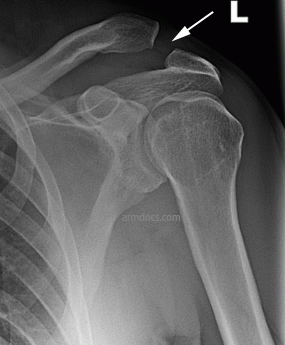Natural History
Following a sprain the capsule and ligaments will usually heal over a period of 6-8 weeks. Complete separations result in persistent deformity of the joint but some patients may regain useful function despite the deformity. However symptoms of pain, discomfort or a “dragging” feeling may persist and may lead to patients seeking treatment later.
What is the pathology of Shoulder Separation?
An acromioclavicular joint separation usually results in damage to the sleeve (capsule) around the joint as well as the stabilising ligaments between the clavicle and coracoid process of the scapula (coracoclavicular ligaments). The injury varies in severity from a simple sprain of the joint to a complete separation resulting in tearing of the capsule and the coracoclavicular ligaments.
How is a Shoulder Separation diagnosed?
The diagnosis is made from the history of the injury and examination of the shoulder. In case of a sprain the joint may be swollen and tender but in case of a complete separation the shoulder sags down making the outer end of the collar bone stick up and appear more prominent than the other side. X-rays of the shoulder will demonstrate the injury. In some instances comparative x-rays of the both shoulders or load-carrying x-rays may be requested to assess the severity of the injury. Special imaging with an MRI scan is not necessary for diagnosis but may be requested to assess associated injuries to the shoulder.
How is Shoulder Separation treated?
Nonoperative Treatment
This is the preferred treatment for the less severe forms of injury such as sprains or partial separations.
Supervised physiotherapy: You may be advised to see a physiotherapist to start a regime of specific exercises to regain movements, improve scapular control and gradually strengthen the rotator cuff.
Sling: A sling may be used for 4 weeks or until the pain has settled. Patients are encouraged to get the shoulder moving as tolerated but to avoid vigorous use or lifting heavy objects for upto 3 months.
Surgery
Surgery may be recommended for the more severe forms of the injury such as a complete separation or for partial separations in high-demand individuals. Reparative surgery is best carried out within the first 2-3 weeks after the injury. For further information see the section on “Primary Acromioclavicular joint repair”.
In some instances, the injury may be diagnosed late or patients may experience persistent symptoms after initial nonoperative treatment. In such instances, surgery may be performed to restore the ligaments supporting the joint. For further information see the section on “Chronic Acromioclavicular joint reconstruction”.
